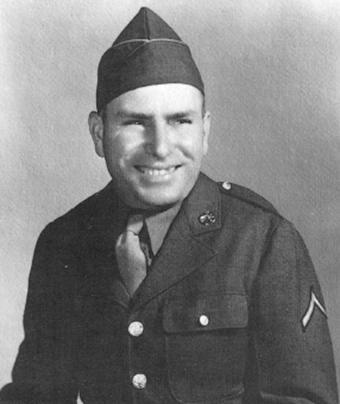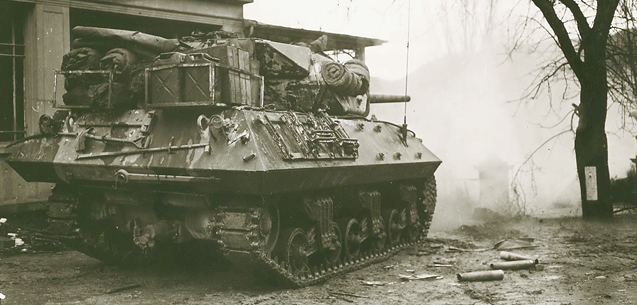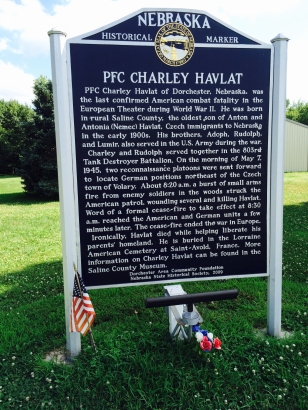On Nov. 12, 1903, the S.S. Pennsylvania sailed into New York harbor, completing a two-week journey from Hamburg.

Pfc. Charley Havlat (ABMC photo)
Among the passengers arriving in the United States that day were the Havlat family, from Ronov nad Doubravou in Bohemia. Ten Havlats in all are shown on the manifest, including 23-year-old Anton Havlat Jr., whose father and namesake was the patriarch of the group.
They told immigration officials they were headed to Nebraska, where they had family near Omaha, and so began an American saga that would see one of their own killed in his ancestral homeland in the final minutes of a cataclysm that touched all of Europe.
This is the story of Pfc. Charley Havlat, the Nebraska-born son of immigrants who became the last American combat casualty in Europe during World War II on the soil his parents had left decades earlier.
The Havlats did indeed settle in Saline County, Nebraska, southwest of Lincoln, and took up farming. In March 1909, Anton Jr. married a fellow immigrant named Antonia Nemec. She had been born in Ondrušky, about 100 kilometers from the Havlats’ home.
A year and a half later, the couple welcomed their first child, Charles, who was born in Pleasant Dale on Nov. 10, 1910. Five more would follow over the next 15 years — three brothers and two sisters — and all would work on the farm with the rest of the family.
Charley and his younger brother Lumir eventually started a trucking company, according to the Omaha World-Herald, hauling grain, rocks and salt around the region, while the brother between them, Rudolph, found construction work via the WPA.
In February 1942, Charley and Rudy got the call from the draft board and entered the Army. Lumir and their youngest brother, Adolph, would follow them into the service.
Charley eventually was assigned to the 803rd Tank Destroyer Battalion and headed overseas.
The 803rd originated as the 103rd Antitank Battalion, initially formed from Washington National Guard units in September 1940. Five days after the attack on Pearl Harbor, the unit was reconstituted as the 803rd, and it eventually moved east from Fort Lewis to Fort Hood, Texas, in the summer of 1942.
There the unit began training on the M-10 tank destroyer before eventually shipping out two days before Christmas to Fort Dix, New Jersey. In June 1943, the 803rd set sail aboard the Queen Mary, arriving in Scotland on the 29th. After taking the train to England, it would train for nearly a year before crossing the channel to France on June 13, 1944.
Attached to the 82nd Airborne, 29th Infantry, and other outfits during the battle of Normandy, the 803rd wound up with the 4th Infantry Division in the fall during the bloody slog through the Huertgen Forest. Pulled out of the line in early December, the 803rd joined the 4th in Luxembourg, supposedly a quiet sector, for some rest. But that respite was short-lived as the German soon launched their last great offensive of the war.
The 803rd was attached to the 5th Infantry Division during the Battle of the Bulge and would remain with that unit for the duration of the war. The Red Diamond helped beat back the German offensive throughout January and crossed the Rhine on March 22 before moving across the heart of Germany throughout the spring.
While the outcome of the war in Europe had been a foregone conclusion for some time by this point, the men in the field continued to press forward. On May 6, the 803rd crossed into Czechoslovakia.

M-10 tank destroyer from the 803rd in Luxembourg (Signal Corps photo)
By this point, German forces had given up the fight on multiple fronts, from Italy to Berlin to the Netherlands and parts of Germany itself. On the evening of May 6, Gen. Alfred Jodl arrived at SHAEF headquarters in Reims, France, to prepare for the surrender of all German forces to the Allies. Jodl signed the surrender papers at 2:41 a.m. on May 7, with hostilities to conclude by the following day.
The troops in the field — on both sides — remained mostly unaware, though, so they continued to go about the business of war until informed otherwise.
So it was that the morning of May 7 saw the Recon Company from the 803rd attached to the 5th’s 2nd Infantry regiment conducting a patrol just inside the Czech border, near the town of Volary (Wallern, to the Germans). At approximately 8:20 a.m., a 30-man German patrol ambushed the American unit led by Lt. Donald T. Warren, firing on them from concealed positions along the road.
According to the 5th Division newspaper, Diamond Dust (via tankdestroyer.net), the Germans opened up on the lead vehicle, an M-8 light armored car, with panzerfaust rounds. The vehicle came out unscathed but got stuck in a ditch while taking evasive action, prompting its occupants to jump out.
Pfc. Charley Havlat was riding in the jeep behind that M-8 and did the same.
“Charley got out his machine gun and so did I,” Pfc. Charles Mashek told the Lincoln Journal Star in 2002. “He stuck his head up, and the sniper got him. Charley didn’t know what hit him.”
Three other men were wounded in the ambush before the Recon Company received orders to withdraw. Clear of the fray around 8:40, the men learned that a cease fire had gone into effect along the line 10 minutes earlier.
The German officer who led the ambush was taken prisoner that day and told the Americans he was not made aware of the cease fire agreement until around 9 a.m. He apologized for the loss of life.
While the 5th Division newspaper from May 8 had already proclaimed that encounter “the last clash with enemy troops” before the cease fire, it wasn’t until the 1990s that the Havlat family became aware that Charley was considered the last American to be killed in action in the European theater.
 Once they received word of their brother’s death, Rudolph and Adolph both traveled to the region to visit his temporary grave — Adolph hitchhiking all the way there from Frankfurt, where he was stationed after the surrender.
Once they received word of their brother’s death, Rudolph and Adolph both traveled to the region to visit his temporary grave — Adolph hitchhiking all the way there from Frankfurt, where he was stationed after the surrender.
Charley Havlat was eventually reburied at the Lorraine American Cemetery near St. Avold, France.
Surviving members of his family have spent years campaigning for a portion of state highway 33 to be named in his honor, with no luck as of yet. But Havlat’s status as the last confirmed American death in the ETO has ensured his footnote in history, if nothing else.